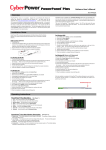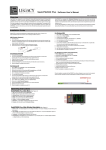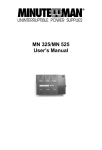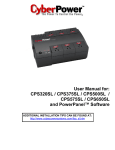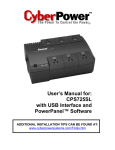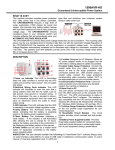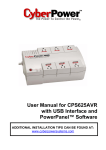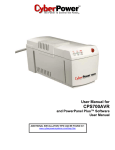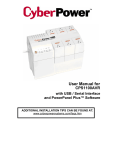Download CyberPower PowerPanel User`s manual
Transcript
PowerPanel Software User’s Manual K01-0PP000A Overview PowerPanel version 2.1.4 or greater is designed for use with Windows 95, Windows 98, Windows Files that have previously been saved will be saved in their original location. Me, Windows NT, Windows 2000, and Windows XP. PowerPanel is equipped with a Scheduled Shutdown feature which can automatically save and The latest version can be downloaded from www.cyberpower-eu.com/download.html. It works in conjunction with the UPS to provide full close open files and then shutdown the computer and UPS at a user specified date and time. Use protection of valuable computer systems, applications and data. of this feature is optional and is not required for the power failure shutdown to occur. In the event of a power failure, PowerPanel automatically saves and closes open files under auto-assigned file names or The use of the PowerPanel software is optional. existing files names after a software controlled delay. The computer and UPS are automatically and battery backup without the software. You must use the software if you wish to have the The UPS unit will provide full surge suppression shutdown to conserve battery power. Files with auto-assigned names will be saved under automatic shutdown feature. C:\PCTemp, where C is the name of your main hard drive. Installation Guide (Cyber Power UPS can provide surge suppression and battery backup without the software. However, if you need to schedule for UPS Auto-shutdown, then it is necessary to install the software.) For Windows 2000 1. Click on Start, point to Settings, then click Control Panel. 2. Double-click on Power Options. 3. On the UPS Tab, click Select. USB Function (Optional) 4. In the UPS selection dialog box, under Manufacturers, select None. 1. Turn off your UPS 5. Exit to the desktop. 2. Connect the serial interface cable to your UPS and the open serial port on the rear panel of the 6. Shutdown the computer, then turn the UPS off and unplug it. computer. If you would like to use USB interface, please connect the USB adapter with the Serial Cable then connect the USB to your computer. (See the figure) 7. Connect the serial interface cable to serial port on the UPS and an open serial port on the computer. (Note: You must use the serial cable that was supplied with the unit). 3. Plug the UPS into an AC outlet, turn the UPS on and start your computer. 8. Plug the UPS into an AC outlet, turn the UPS on, and then start your computer. 4. .Follow the instructions on the User’s Manual to complete the installation. 9. Insert the PowerPanel™ software disk into the floppy drive. 10. Click on Start, point to Settings, and then click Control Panel. 11. Double-click on Add / Remove Programs. 12. Click the Install Button, and follow the on-screen instructions. 13. When the installation is completed, remove the floppy disk. For Windows 95 /98 /ME For Windows XP (Home and Professional) 1. Turn the UPS off and unplug it. 1. Click on Start, and then click on Control Panel. 2. Connect the serial interface cable to serial port on the UPS and an open serial port on the back of the computer. (Note: You must use the serial cable that was supplied with the unit). 2. Double-click on Power Options, and then click the UPS tab. 3. Set the manufacturer to None. 3. Plug the UPS into an AC outlet, turn the UPS on and start your computer. 4. Exit to the desktop and then shutdown your computer. 4. Once the computer was finished booting, insert the PowerPanel 5. Connect the serial interface cable to serial port on the UPS and an open serial port on the back of disk into the floppy drive. 5. Click on Start, point to Settings, and then click Control Panel. the computer. (Note: You must use the serial cable that was supplied with the unit). 6. Double-click on Add / Remove Programs. 6. Plug the UPS into an AC outlet, turn the UPS on and then start your computer. 7. Click the Install Button, and follow the on-screen instructions. 7. Insert the PowerPanel 8. When the installation is completed, remove the floppy disk. 8. Click on Start, and then click Control Panel. disk into the floppy drive. 9. Double-click on Add or Remove Programs. For Windows NT 10. Click on Add New Programs, and then click the CD or Floppy Button. 1. Click on Start, point to Settings, then click Control Panel. 11. Follow the on-screen instructions. 2. Double-click the UPS Icon. 12. When the installation is completed, remove the floppy disk. 3. Remove the checkmark from the box labeled UPS is installed on, and Click OK. 4. Acknowledge the message that the UPS is in an unknown state and exit to the desktop. When the installation is completed, the PowerPanel software will appear on your screen for a few 5. Shutdown your computer. seconds, and then minimize. It will appear as a blue and white battery icon located in the system 6. Turn off the UPS and unplug it. tray, near the clock. 7. Connect the serial interface cable to serial port on the UPS and an open serial port on the back of the computer. (Note: You must use the serial cable that was supplied with the unit). 8. Plug the UPS into an AC outlet, turn the UPS on and then start your computer. 9. Click on Start, point to Settings, then click Control Panel. 10. Double-click on Add / Remove Programs. 11. Click the Install Button and follow the on-screen instructions. 12. When the installation is complete, remove the floppy disk. Operating Instructions PowerPanel Main Window Description 1. Minimize Button: (See Figure 1 ) This button is used to minimize the software. 2. Power : Clicking on the power button will exit the PowerPanel window. 3. Setup : Click the setup button to open the Setup Window. 4. Log: Click on the log button to open the Log Window. 5. Schedule: Click the schedule button to open the Scheduled Shutdown Window. 6. AC Power Indicator: This indicator appears in a green color when AC power in normal. When the power fails, the indicator will change to a red color with an “X” through it. 7. Battery OK Indicator: This indicator appears in a green color when AC power is normal and the unit and software are communicating. 8. Scheduled Shutdown: If there is a shutdown scheduled within seven days, the information will be displayed here. The user can schedule a shutdown in the Scheduled Shutdown Window. 9. Final Countdown: When the final countdown timer reaches zero, the software will begin shutting down the system. This can be adjusted in the Setup Window. PowerPanel Setup Window (See Figure 2 ) 1. Delay between Warning Messages: User adjustable setting for the delay between the audible alarms that occur during a power failure. 2. Time between Power Failure and Initial Warning: This setting determines the delay between when the power fails and the first audible alarm. 3. Time between Power Failure and Shutdown: This is the user controllable delay between when the power fails and the software starts the shutdown process. If unchecked, the unit will run on battery until the low battery signal is received (2 minutes of backup time remaining) and then start the shutdown process. 4. Play Voice: Voice is being played when the UPS is turning on or facing a power outage. 5. UPS is Installed On: This shows the current port that the UPS is using. The port assigned to the UPS needs to be used exclusively for the PowerPanel software. 6. OK: This button is used to exit the setup window and save any changes. 7. Cancel: This button is used to exit the setup window without saving any changes. 8. About: This button will display information about the software, as well as contact information. PowerPanel Log Window (See Figure 3 ) 1. Display Window: This area displays either the Event Log or the Closed Application Information. 2. Event Log: Select this option to view PowerPanel events such as program start, program end, power failure and low battery. 3. Closed Application Information: Select this option to view the file names of applications that were saved by PowerPanel . Please note: If an application has an existing file name, it will be saved under that file name and not appear in this window. 4. OK: This button is used to exit the log window and save any changes. 5. Cancel: This button is used to exit the log window without saving any changes. 6. Clear: This button is used to clear the information in the selected log. PowerPanel Shutdown Window (See Figure 4 ) 1. Display Window: Any schedule information will be displayed here. 2. Special Setting: This option is used to schedule a shutdown at a specific date and time. 3. Weekly Setting: This option is used to schedule a shutdown for a specific time and day of the week. 4. OK: This button is used to exit the shutdown window and save any changes. 5. Cancel: This button is used to exit the shutdown window without saving any changes. 6. Add: This button is used to add an item to the schedule. 7. Delete: This button is used to delete the selected item. 8. Day, Date and Time: This is the area where you select the day, date and time that you want the shutdown to occur. Once you have selected it, click the Add Button to add the item to the schedule. Please note: The use of the schedule is optional and will have no effect on the shutdown of your system during a power failure. This feature is simply used if you want to have your computer automatically shutdown at a scheduled time. Using the Windows NT UPS Service Using the Windows 2000 UPS Service If you are running Windows NT, you may choose to use the Windows NT UPS service instead of If you are running Windows 2000, you may choose to run the Windows 2000 UPS service instead of PowerPanel . PowerPanel . You can run either PowerPanel or the NT UPS service, but not both. You can run either PowerPanel or the Windows 2000 UPS service, but not both. To configure the Windows NT UPS Service: To Configure the Windows 2000 UPS Service: 1. Click on Start, point to Settings, then Control Panel. 1. Click on Start, point to Settings, then Control Panel. 2. Double-click the UPS Icon. 2. Double-click on Power Options, and on the UPS Tab, click Select. 3. Select the COM port that the UPS is connected to. 3. In the UPS Selection Dialog Box, under Select Manufacturer, select Generic. 4. Set the Power Failure Signal to Negative. 4. Under Select Model, select Custom, and on the UPS Tab, click Configure. 5. Set the Low Battery Signal to Negative. 5. Set Power Fail / On Battery to Negative. 6. Set the Remote UPS Shutdown Signal to Positive. 6. Set Low Battery to Negative. 7. Click OK. 7. Set UPS Shutdown to Positive, and then Click OK. Please note: This service must be stopped in order to use the PowerPanel software. To stop Please note: This service must be stopped in order to run PowerPanel . To disable the service, set the service, remove the checkmark from Uninterruptible Power Supply is installed on. Click OK. the Manufacturer to None. Acknowledge the message that the UPS is in an unknown state and exit to the desktop. Please note: You must be logged on as an administrator or a member of the administrator’s group to make these changes. Network policies may also prevent you from making these changes. Please contact your network administrator for further assistance. Testing Your UPS System Once you have set up your UPS system, you may wish to test it. Make sure that the UPS has been charged for at least 4 hours before performing this test. restart your computer. Please allow 4 hours for the UPS to recharge before attempting another self-test. If you are using PowerPanel software: 1. With your UPS and computer on, open an application such as notepad. 2. Enter some data into the application. 3. Unplug the UPS from the AC outlet. When a power failure occurs, PowerPanel will appear on the screen. The outlet and battery symbols will change to indicate a power failure. The countdown timer will move towards zero. When the timer reaches zero, the software will begin to save and close any open applications. The software will auto-assign names to any files that have not been previously saved, and then save the file to the C:/PCTemp folder which is located in the root directory of your C drive (where C is the name of your main hard drive). Once all open files have been saved and closed, PowerPanel will shutdown the operating system. Once the test has been completed, plug the UPS back into the wall and turn it back on. You may then Once the operating system is shutdown, the UPS will turn off If you are NOT using PowerPanel software: 1. Have your computer and UPS turned on. 2. Unplug the UPS from the wall to simulate a power failure. 3. The UPS will begin beeping, indicating a power failure. 4. Save and close any open files. 5. Shut down the operating system. 6. Once the computer system is shutdown, turn the UPS off. As the battery discharges, the unit will beep more rapidly, indicating that the battery is nearing discharge. Once the test is complete, plug the UPS back in and start your computer. Please allow 4 hours for the UPS to recharge before attempting another self-test. within 90 seconds. Wait until the UPS has turned off before plugging the UPS back into the outlet. Entire contents copyright ©2003 CyberPower Systems, Inc. All rights reserved. Reproduction in whole or in part without permission is prohibited. PowerPanel is a trademark of CyberPower Systems, Inc. K01-0PP000A


